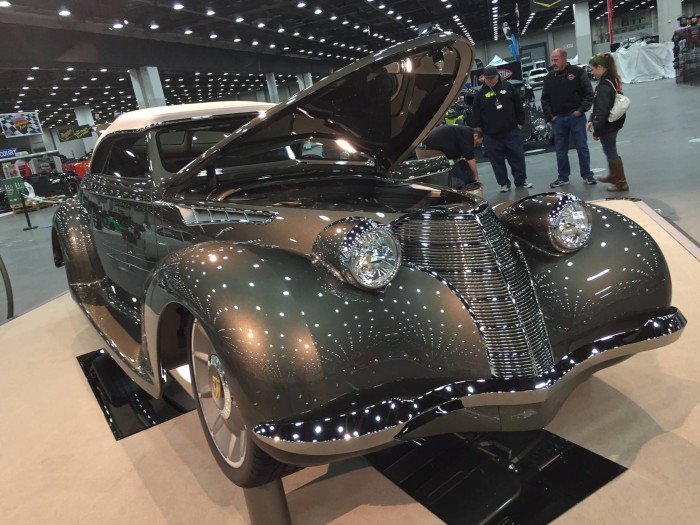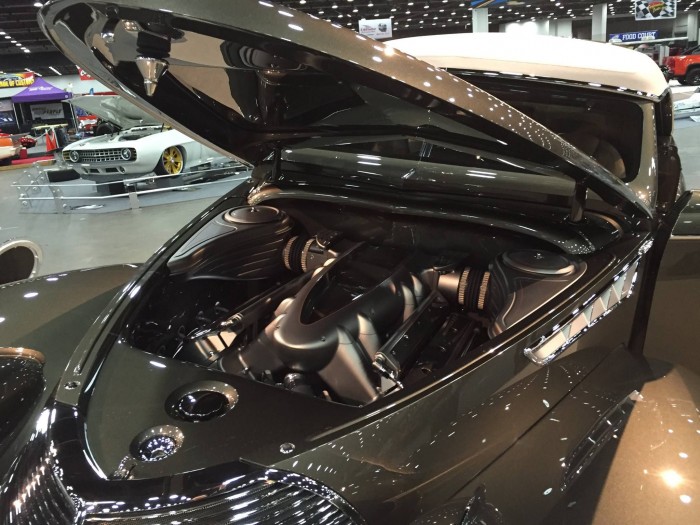Two-owner, “last-of-its-kind” 1939 Oldsmobile takes Ridler Award
Posted on Jun 2, 2022 in Featured | 2 comments

The catalogs and reference books all say it shouldn’t exist, but according to both its owner and the shop that built it, the 1939 Oldsmobile Series 60 that won the Ridler Award at this past weekend’s Detroit Autorama not only came from the factory as a convertible but is also the last of its kind.
The short-lived Series 60 represented the most basic Oldsmobile one could buy in the late 1930s: a small six-cylinder-powered car fitted with the GM A-body shared with Chevrolet and Pontiac. While Oldsmobile introduced a convertible in the Series 60 lineup in 1940, for 1939 Lansing only offered a business coupe, a club coupe, a two-door sedan, and a four-door sedan. A literature check at the R.E. Olds Transportation Museum in Lansing, Michigan, turned up no evidence of a convertible Model 60 from that year.
But Billy Thomas of Corpus Christi, Texas, claims that the car he started with when he set out to build a show-winning car was a one-owner 1939 Model 60 convertible, a claim reiterated by the shop that built the car for him, Customs and Hot Rods of Andice near Georgetown, Texas.
“It was an original convertible when we started with it,” said Michael Kaiser, the shop manager at Customs and Hot Rods of Andice. “Both the title and frame say that it’s a 1939 Model 60 convertible.”

However it started out, not much of the original car remains today in the custom that Thomas nicknamed “Olds Cool.” Kaiser estimated about 90 percent of the body has been reshaped or modified in some way. “The body evolved as we went, with input from myself, the owner, Levi Green, and Christian Dotson, who worked in GM Design for 12 years.” After using foam carvings to refine their ideas, they then created bucks from which the 18-gauge-steel body panels were formed.
The Art Morrison chassis that the shop started out with when building the car proved “a good basis to mock the car up with,” Kaiser said, but the shop eventually scrapped much of the frame for custom-fabricated sections. Despite the low stance, it uses static coilovers for its independent front suspension and banjo-style rear axle.

Power comes from an Oldsmobile 455-cu.in. V-8 that both Thomas and Kaiser said was massaged by Joe Mondello before he died. It now displaces 470 cubic inches and puts out about 650 horsepower, thanks in part to a one-off Wilson electronic fuel injection intake manifold with twin throttle bodies. A 4L60E automatic transmission backs the big V-8.
According to Kaiser, the staff at Customs and Hot Rods of Andice handled every aspect of the build except for the paint, which Charley Hutton sprayed in a custom-mixed color he called Kona Brown. The four-year build is the shop’s first Ridler Award.

In addition to the Oldsmobile, a 1938 Graham 97, a 1952 Mercedes 170S, a 1941 Ford roadster pickup, a 1961 Chevrolet Impala two-door hardtop station wagon, a 1937 Ford coupe, a 1940 Willys coupe, and a 1976 Australian Ford Falcon coupe qualified for the Great 8, from which the winner of the Autorama’s annual Don Ridler Memorial Award is selected. The winner takes home $10,000 in prize money.





I’ve never understood claiming a car was “built” from a car that had been built already by Olds. This was basically built from scratch. Why not do that next to the ’39 car that provided the inspiration and still have the ’39 remaining when you’re done? Show them side-by-side throughout the process. Then no one would doubt the ’39 existed. Obvious, isn’t it?
I read an article once about a near mint ’23 Chevy coupe. They were proud of cutting it up to make just another “T-bucket”. Sad.
Its actually all about the VIN or serial number. Hand build a car and it becomes a speciallty car like a kit car subject to different laws and requirements (especially now) versus building a custom on a car from 1939 which is just subject to laws from 1939 or prior to emissions…